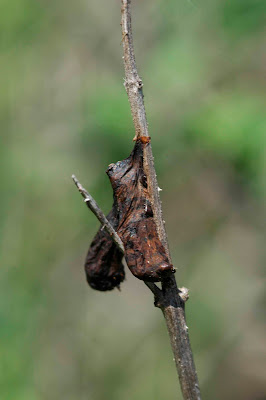 |
| Malta star-thistle (Centaurea melitensis) Similar species is yellow starthistle (Centaurea solstitialis) |
Here recently, I must admit that I felt a little relieved to know that we don't have the bastard cabbage (Rapistrum rugosum) in our neighborhood. Then last Wednesday, I met Ricky Linex, a wildlife biologist with the Natural Resources Conservation Service, at a Riparian Workshop (part of my Texas Master Naturalist training). On a creek bank near Horseshoe Bay, he pulled up a dark green plant and said it was the invasive thistle he mentioned to me earlier.
Hmmm.
In the meantime, James and I had been eyeing a healthy crop of big green plants growing along the street that adjoins the Meadow. Uh oh.
After I got home, I took a closer look at the plants.
Dang.
We've got Malta star-thistle IN OUR WILDSCAPE!!
Yesterday evening, James started pulling it up. I pulled up more around noon today and walked across the street, too, to yank up some growing in our neighbor's yard. We've got a LOT more to pull. And there's more young ones coming up.
Drat.
Sigh.
Just now, I reported our thistle to Early Detection & Distribution Mapping System, a web-based mapping system for documenting invasive species distribution. My Record ID for the Malta star-thistle is 2027636.
LATER THAT EVENING...
 |
| It took everything I had to pull up some of the thistle!!! I think it should have a similar name as that bastard cabbage.... |
 |
| Daunting work, but we kept at it. |
 |
| I asked James to take a photo of what's UNDER a cluster of thistle. NOTHING. |
 |
| James won the prize for the biggest thistle of the evening. |
 |
| We removed the majority of the Malta star-thistle...for now. We'll have to keep pulling until hopefully we win and not the thistle. |
* * * *
More info on invasives:
National Invasive Species Information Center
Invasive Species, AgriLife Extension, Prairie View A&M University
UPDATE APRIL 2, 2012
I asked Ricky some questions about best how to control the species:
"There are chemical methods, but the plants might still produce seed because of the length of time required for the chemical to work. Hoeing or pulling will get roots and all. According to a forest service pub mowing and I suppose weed-eating can cause the plant to send out side branches. Google "Field Guide for Managing Malta Star-thistle" to read more."
Can the piled up bunches of pulled thistle still make seeds?
"If it hasn't produced yellow flowers, it won't now make seed. The ones you've pulled were caught early so they are done. And forgot to add that the untouched plants will bloom different heads through early summer."
UPDATE, MAY 12, 2012
I am still pulling Malta star-thistle and beggar's ticks (Torillis arvensis), another non-native. The species is also called hedge parsley. You've seen the stuff...it has pretty white flowers that resemble baby's breath or Queen Anne's lace. Then the flowers turn into nasty burrs that stick to socks and fur. As I was yanking the plants, I noticed that the species--like most invasive weeds--crowds out everything and creates a monoculture (nothing grows under it)!
 |
| My pile of thistle and beggar's ticks. |














































